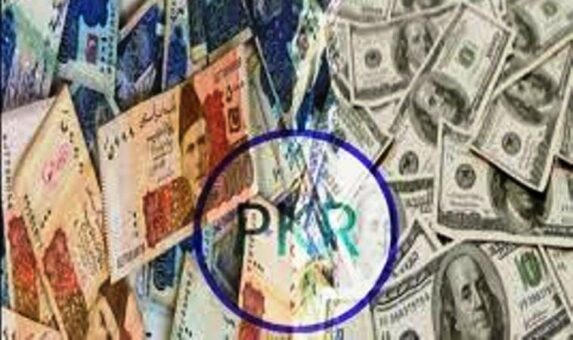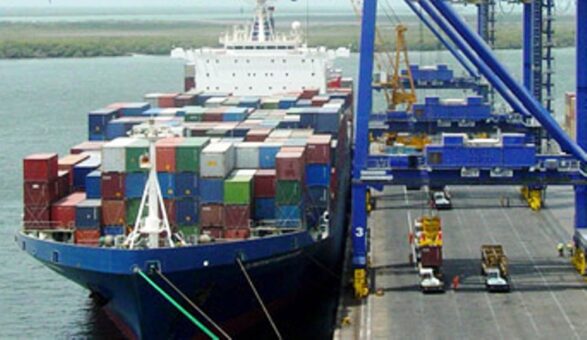The equity market saw modest gains on Wednesday, with the benchmark KSE-100 index closing at 38,929 points, up from the previous day’s 38,896 points, marking an increase of 32 points.
(more…)Author: Faisal Shahnawaz
-

Rupee maintains level against dollar
KARACHI: The Pak Rupee maintained level against dollar on Wednesday despite higher demand for import and corporate payments.
The rupee ended Rs138.81 to the dollar from previous day’s close of Rs138.82 in interbank foreign exchange market.
The interbank foreign exchange market was market initiated in the range of Rs138.80 and Rs138.85.
The market recorded day high of Rs138.88 and low of Rs138.78 and closed at Rs138.81.
Currency experts said that due to declining import bill the demand for the greenback was eased.
The trade deficit has narrowed by 11 percent during first eight months of current fiscal year owing decline in import bill, Pakistan Bureau of Statistics (PBS) said on Tuesday.
The trade deficit shrank to $21.52 billion during July – February 2018/2019 as compared with the deficit of $24.19 billion in the corresponding period of the last fiscal year.
The import bill of the country was declined by 6.13 percent to $36.63 billion during first eight months of current fiscal year as compared with $39.03 billion in the same period of the last fiscal year.
The exchange rate in the open market was also remained stable.
The buying and selling of dollar was recorded at Rs138.30/Rs138.80, the same previous day’s level, in cash ready market.
-

Return filers enjoy tax free banking transactions
KARACHI: The income tax filers have started enjoying withholding tax exemption on transactions of money through banking channels.
After the implementation of amendments made through Finance Supplementary (Second Amendment) Act, 2019 the income tax return filers are no more required to pay 0.6 percent withholding tax on cash withdrawal.
The exemption is applicable on the taxpayers, who are appeared on the Active Taxpayers List (ATL) for tax year 2018.
Before the amendment the rate of withholding tax was 0.3 percent for return filers on cash withdrawal of Rs50,000 in aggregate from banking system per day.
In order to give incentives to compliant taxpayers and encourage return filing the government exempted the withholding tax on cash withdrawal.
Now the withholding tax on any banking transactions i.e. cash or non-cash transactions is only applicable on non-filers of income tax returns.
The non-filers are required to pay 0.6 percent on transactions under Section 231A and Section 236P of Income Tax Ordinance, 2001 on transactions of Rs50,000 per day.
Tax experts said that the withholding tax on cash withdrawal on non-filers was major impediment in improving banking deposits.
They said that it would encourage non-compliant to file their returns and further the measure would also reduce channels of cash economy.
-

Duty free import of plant, machinery allowed for industrial units
KARACHI: Federal Board of Revenue (FBR) has allowed duty free import of plant and machinery by industrial and manufacturing units.
The exemption has been allowed through Finance Supplementary (Second Amendment) Act, 2019 under Chapter 84 and 85 of Customs Act, 1969.
The FBR said that plant and machinery shall be allowed zero percent customs duty but it should be excluded consumer durable goods and office equipment as imported by Greenfield industries, intending to manufacture taxable goods, during their construction and installation period.
The exemption of customs duty is available on fulfillment of following conditions, namely:
(a) the importer is registered under the Sales Tax Act on or after the first day of July, 2019
(b) the industry is not established by splitting up or reconstruction or reconstruction of an undertaking already in existence or by transfer of machinery or plant from another industrial undertaking in Pakistan.
(c) exemption certificate issued by the commissioner Inland Revenue having jurisdiction; and
(d) The goods shall not be sold or otherwise disposed of without prior approval of the FBR and the payment of customs duties and taxes leviable at the time of import.
-

Mobile handset levy increased up to Rs7,000 per set
ISLAMABAD: The government has increased mobile handset levy up to Rs7,000 per set from the date of implementation of Finance Supplementary (Second Amendment) Act, 2019.
The government through Finance Act, 2018 introduced mobile hand set levy at different rates as values of smart phones were determined in Pak Rupee value.
However, through Finance Supplementary (Second Amendment) Act, 2019, the determination of value of smart phones has been changed to US Dollar and the categories have been increased to six.
Following are the amendment to levy on mobile handsets:
01. Mobile phones have cost and freight value up to $30: No levy
02. Mobile phones have cost and freight value above $30 and up to $100: No levy
03. Mobile phones have cost and freight value above $100 and up to $200: Rs500
04. Mobile phones have cost and freight value above $200 and up to $350: Rs1,500
05. Mobile phones have cost and freight value above $350 and up to $500: Rs3,500
06. Mobile phones have cost and freight value above $500: Rs7,000
Previously there were four categories, which were as follow:
01. Where Import value of handset (including duties and taxes) does not exceed Rs.10,000/: No levy
2. Where Import value of handset (including duties and taxes) exceeds Rs.10,000 but does not exceed Rs.40,000/: Rs1,000
3. Where Import value of handset (including duties and taxes) exceeds Rs.40,000 but does not exceed Rs.80,000/: Rs3,000
4. Where Import value of handset (including duties and taxes) exceeds Rs.80,000/: Rs5,000
Related Stories
-

ECC approves Rs2 billion for Ramazan Relief Package
ISLAMABAD: The Economic Coordination Committee of the Cabinet (ECC) convened on Tuesday under the chairmanship of Finance Minister Asad Umar and approved a comprehensive Ramazan Relief Package worth Rs2 billion.
(more…) -

Trade deficit narrows by 11 percent in eight months
ISLAMABAD: The trade deficit has narrowed by 11 percent during first eight months of current fiscal year owing decline in import bill, Pakistan Bureau of Statistics (PBS) said on Tuesday.
The trade deficit shrank to $21.52 billion during July – February 2018/2019 as compared with the deficit of $24.19 billion in the corresponding period of the last fiscal year.
The import bill of the country was declined by 6.13 percent to $36.63 billion during first eight months of current fiscal year as compared with $39.03 billion in the same period of the last fiscal year.
However, exports posted growth of 2 percent to $15.11 billion during the period under review as compared with $14.83 billion in the corresponding period of the last fiscal year.
Experts said that the import bill of the country declined owing to several restrictions imposed by the government including condition of advance payment and regulatory duty on luxury and non-essential items.
On the other side exports failed to reflect the incentives granted to manufacturing and export sector by the government.
The trade deficit reduced sharply in February 2019 to $2.29 billion from the deficit of $2.86 billion in February 2018, showing decline of 20.12 percent.
In the same period imports fell by 12.26 percent to $4.18 billion as compared with $4.76 billion in February 2018.
The export growth was flat during the month to $1.88 billion as compared with $1.89 billion.
Related Stories: Pakistan’s import bill declines by 19.14pc in January -

Rupee ends flat against dollar
KARACHI: The Pak Rupee ended flat against dollar on Tuesday amid higher demand for import and corporate demand.
The rupee ended Rs138.82 to the dollar from previous day’s close of Rs138.82 in interbank foreign exchange market.
The interbank foreign exchange market was initiated in the range of Rs138.80 and Rs138.85.
The market recorded day high of Rs138.90 and low of Rs138.82 and closed at Rs138.82.
Currency experts said that the scheduled repayment of foreign loans had pressure on the local currency. However, they said that expected inflows of $4.1 billion during next few days would help the local currency to gain values.
The exchange rates in the open market were also flat.
The buying and selling of dollar was recorded at Rs138.30/Rs138.80 from previous day’s closing of Rs138.30/Rs138.70 in cash ready market.
Related Stories
Rupee falls by 26 paisas against dollar -

Equity market witnesses lackluster trading activity
KARACHI: Trading at the equity market was remained lackluster as the taxation measures failed to attract investors.
The benchmark KSE-100 index closed at 38,896 points as against 38,924 points showing a decline of 28 points.
The government on the demand of stock market abolished the advance tax on sale and purchase of shares and also allowed loss carry forward for next three years.
Analysts at Arif Habib Limited said that the market repeated the pattern witnessed in the past couple of sessions, viz an increase in the beginning of session followed by selling till the end.
The index again traded in a narrow range and oscillated between +106 points and -276 points.
Traded volumes improved over the day but were still lethargic considering the hey-days.
The banks again led the volumes table (18.3 million), contributed by BOP (11.5 million), followed by Cement sector which took the cue from anticipated construction activity as indicated by the prime minister.
Large cap banks and E&P remained on the negative side throughout the session and were the main reasons for slide in index.
Sectors contributing to the performance include Banks (-92 points), Autos (-12 points), Cement (+28 points), E&P (+24 points), Pharma (+11 points).
Volumes increased from 68 million shares to 90 million shares (+32 percent DoD). Average traded value also increased by 19 percent to reach US$ 28.3 million as against US$ 23.8 million.
Stocks that contributed significantly to the volumes include BOP, WTL, DCL, KEL and FCCL, which formed 43 percent of total volumes.
Stocks that contributed positively include OGDC (+26 points), ABOT (+13 points), PMPK (+11 points), HMB (+9 points), and LUCK (+9 points). Stocks that contributed negatively include MEBL (-32 points), HBL (-27 points), MCB (-20 points), ENGRO (-11 points) and BAFL (-10 points).
Related Stories
Equity market sheds 26 points in range bound trading -

SBP allows exemptions, relaxations for housing finance
KARACHI: The State Bank of Pakistan (SBP) has allowed certain exemptions and relaxations in prudential regulations for promoting low cost housing finance.
A circular issued a day earlier, the SBP said that in order to promote low cost housing finance in the country, it has been decided to define the low cost housing as part of SBP’s regulatory framework and allow certain regulatory relaxations for banks/DFIs.
To qualify under low-cost housing finance, the borrower has to fulfill the following criteria:
• Maximum value of the housing unit/apartment up to Rs3 million
• Covered area of the housing unit / apartment up to 850 square feet in urban areas
• Loan size up to Rs2.7 million
To further encourage and facilitate the Banks/DFIs to pursue low-cost housing finance, regulatory exemptions/relaxations in the following Prudential Regulations (PRs) for housing finance are being advised:
i. Regulation HF 4: Loan to Value Ratio (LTV): LTV ratio of upto 90:10 shall be maintained for low cost housing finance.
ii. Regulation HF 5: Limit on Exposure against Real Estate Sector: Financing extended to low cost housing, shall be exempted from exposure limit of 10 percent on real estate sector.
iii. Regulation HF-7: Property Assessment: For the purpose of financing low cost housing units, banks/DFIs are allowed to apply the valuation of single unit on all the units of the same society/colony instead of conducting separate valuation for each unit constructed on the same layout and size.
iv. Regulation HF 9: General Reserve against Housing Finance: Banks/DFIs are exempted from general reserve requirement against the financing extended to low cost housing.
Banks/DFIs have been directed to ensure circulation of these exemptions/relaxations in the regulations for housing finance among all their offices/branches for meticulous compliance in letter and spirit.